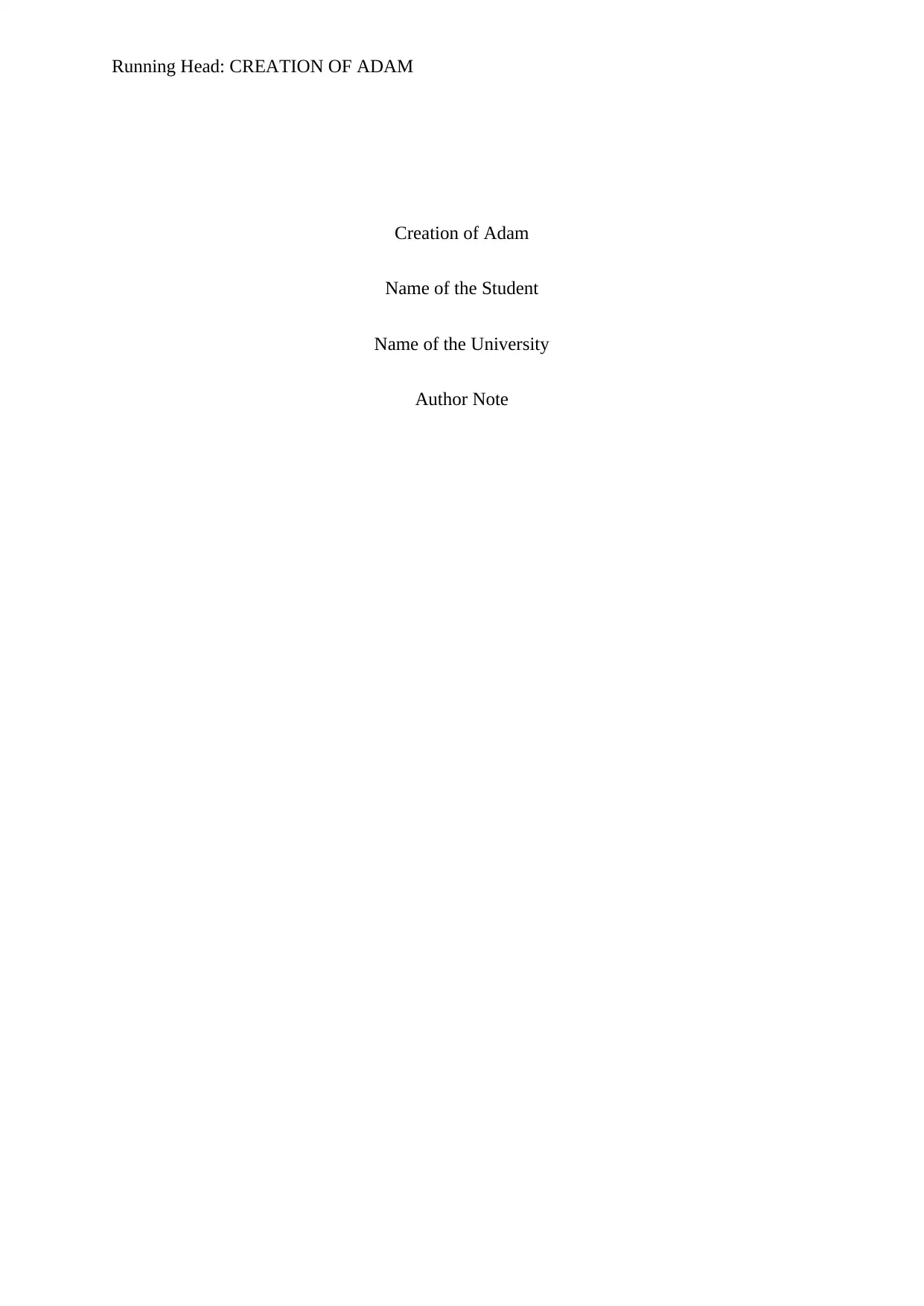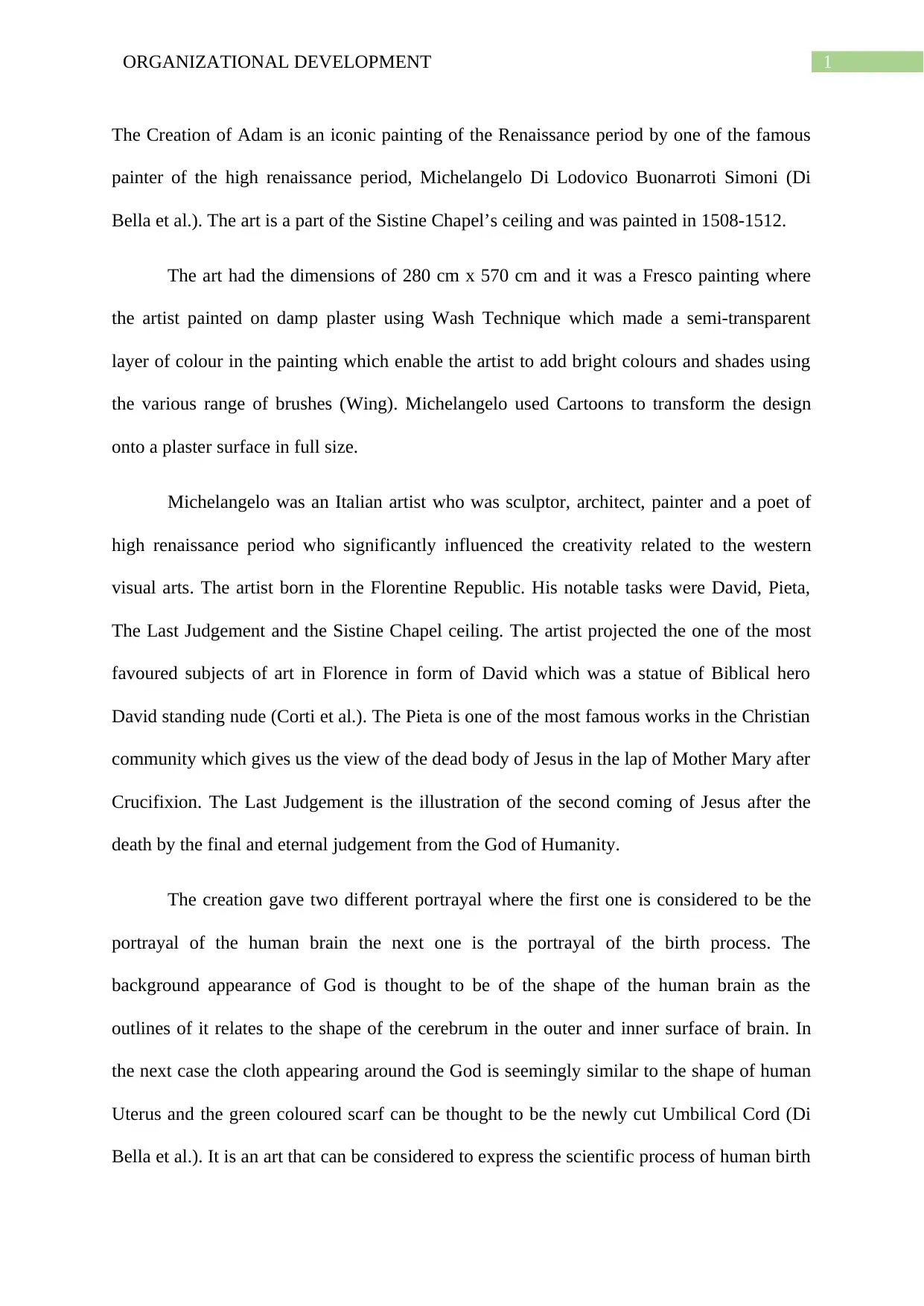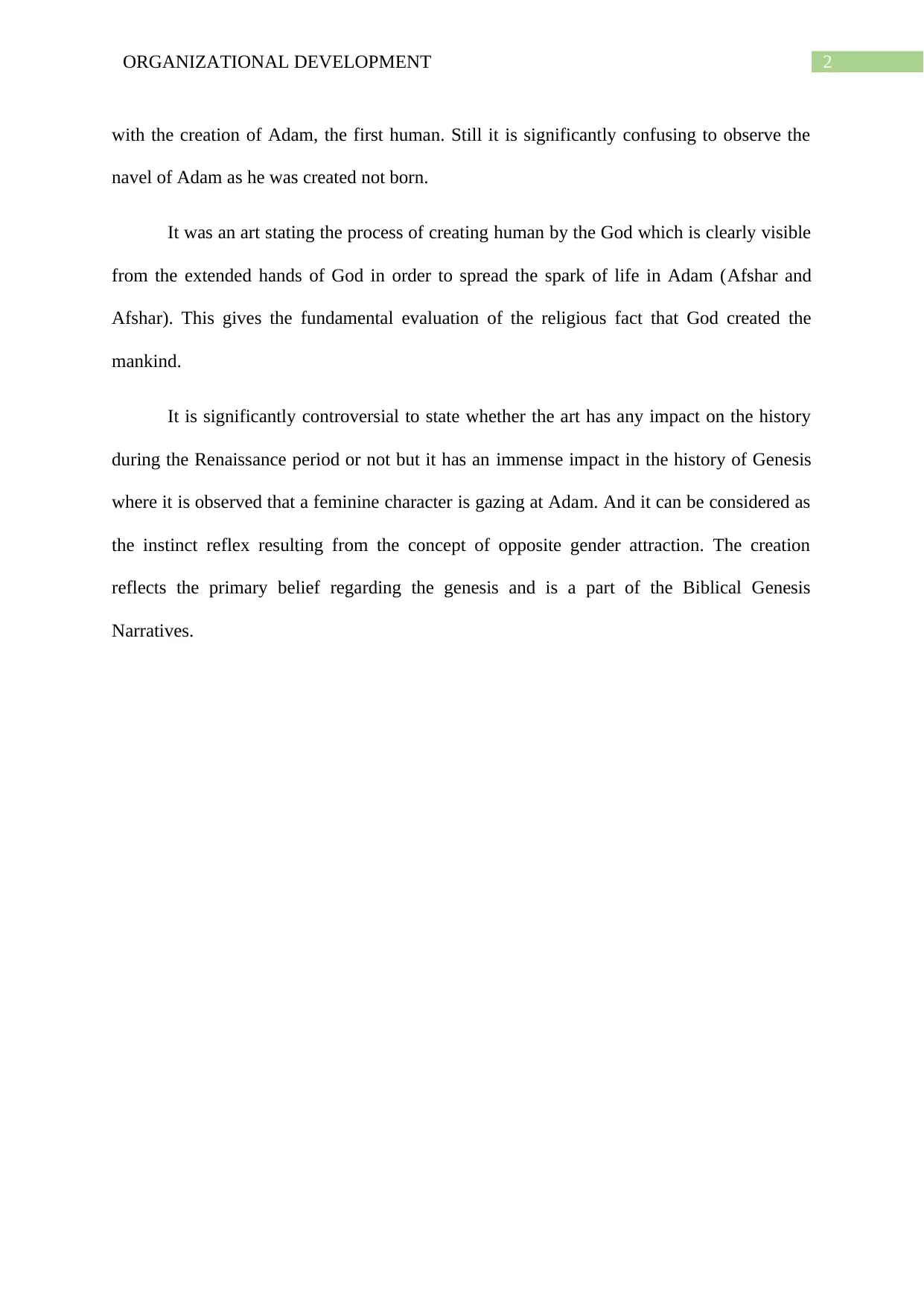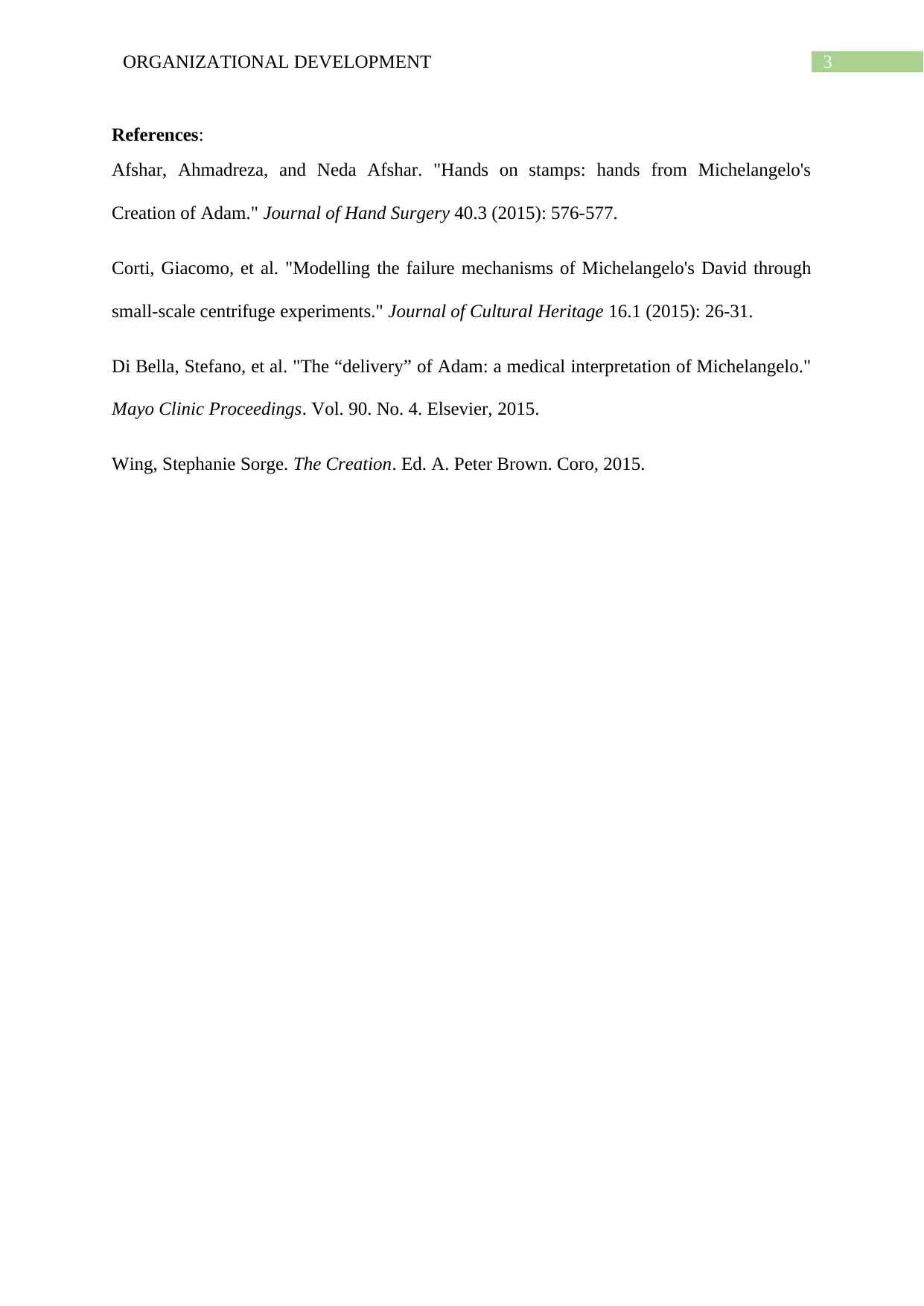Creation of Adam - Renaissance Painting by Michelangelo
VerifiedAdded on 2023/06/09
|4
|717
|422
AI Summary
The Creation of Adam is an iconic painting of the Renaissance period by Michelangelo. This article explores the painting technique, the artist's notable works, and the controversial interpretations of the art.
Contribute Materials
Your contribution can guide someone’s learning journey. Share your
documents today.

Running Head: CREATION OF ADAM
Creation of Adam
Name of the Student
Name of the University
Author Note
Creation of Adam
Name of the Student
Name of the University
Author Note
Secure Best Marks with AI Grader
Need help grading? Try our AI Grader for instant feedback on your assignments.

1ORGANIZATIONAL DEVELOPMENT
The Creation of Adam is an iconic painting of the Renaissance period by one of the famous
painter of the high renaissance period, Michelangelo Di Lodovico Buonarroti Simoni (Di
Bella et al.). The art is a part of the Sistine Chapel’s ceiling and was painted in 1508-1512.
The art had the dimensions of 280 cm x 570 cm and it was a Fresco painting where
the artist painted on damp plaster using Wash Technique which made a semi-transparent
layer of colour in the painting which enable the artist to add bright colours and shades using
the various range of brushes (Wing). Michelangelo used Cartoons to transform the design
onto a plaster surface in full size.
Michelangelo was an Italian artist who was sculptor, architect, painter and a poet of
high renaissance period who significantly influenced the creativity related to the western
visual arts. The artist born in the Florentine Republic. His notable tasks were David, Pieta,
The Last Judgement and the Sistine Chapel ceiling. The artist projected the one of the most
favoured subjects of art in Florence in form of David which was a statue of Biblical hero
David standing nude (Corti et al.). The Pieta is one of the most famous works in the Christian
community which gives us the view of the dead body of Jesus in the lap of Mother Mary after
Crucifixion. The Last Judgement is the illustration of the second coming of Jesus after the
death by the final and eternal judgement from the God of Humanity.
The creation gave two different portrayal where the first one is considered to be the
portrayal of the human brain the next one is the portrayal of the birth process. The
background appearance of God is thought to be of the shape of the human brain as the
outlines of it relates to the shape of the cerebrum in the outer and inner surface of brain. In
the next case the cloth appearing around the God is seemingly similar to the shape of human
Uterus and the green coloured scarf can be thought to be the newly cut Umbilical Cord (Di
Bella et al.). It is an art that can be considered to express the scientific process of human birth
The Creation of Adam is an iconic painting of the Renaissance period by one of the famous
painter of the high renaissance period, Michelangelo Di Lodovico Buonarroti Simoni (Di
Bella et al.). The art is a part of the Sistine Chapel’s ceiling and was painted in 1508-1512.
The art had the dimensions of 280 cm x 570 cm and it was a Fresco painting where
the artist painted on damp plaster using Wash Technique which made a semi-transparent
layer of colour in the painting which enable the artist to add bright colours and shades using
the various range of brushes (Wing). Michelangelo used Cartoons to transform the design
onto a plaster surface in full size.
Michelangelo was an Italian artist who was sculptor, architect, painter and a poet of
high renaissance period who significantly influenced the creativity related to the western
visual arts. The artist born in the Florentine Republic. His notable tasks were David, Pieta,
The Last Judgement and the Sistine Chapel ceiling. The artist projected the one of the most
favoured subjects of art in Florence in form of David which was a statue of Biblical hero
David standing nude (Corti et al.). The Pieta is one of the most famous works in the Christian
community which gives us the view of the dead body of Jesus in the lap of Mother Mary after
Crucifixion. The Last Judgement is the illustration of the second coming of Jesus after the
death by the final and eternal judgement from the God of Humanity.
The creation gave two different portrayal where the first one is considered to be the
portrayal of the human brain the next one is the portrayal of the birth process. The
background appearance of God is thought to be of the shape of the human brain as the
outlines of it relates to the shape of the cerebrum in the outer and inner surface of brain. In
the next case the cloth appearing around the God is seemingly similar to the shape of human
Uterus and the green coloured scarf can be thought to be the newly cut Umbilical Cord (Di
Bella et al.). It is an art that can be considered to express the scientific process of human birth

2ORGANIZATIONAL DEVELOPMENT
with the creation of Adam, the first human. Still it is significantly confusing to observe the
navel of Adam as he was created not born.
It was an art stating the process of creating human by the God which is clearly visible
from the extended hands of God in order to spread the spark of life in Adam (Afshar and
Afshar). This gives the fundamental evaluation of the religious fact that God created the
mankind.
It is significantly controversial to state whether the art has any impact on the history
during the Renaissance period or not but it has an immense impact in the history of Genesis
where it is observed that a feminine character is gazing at Adam. And it can be considered as
the instinct reflex resulting from the concept of opposite gender attraction. The creation
reflects the primary belief regarding the genesis and is a part of the Biblical Genesis
Narratives.
with the creation of Adam, the first human. Still it is significantly confusing to observe the
navel of Adam as he was created not born.
It was an art stating the process of creating human by the God which is clearly visible
from the extended hands of God in order to spread the spark of life in Adam (Afshar and
Afshar). This gives the fundamental evaluation of the religious fact that God created the
mankind.
It is significantly controversial to state whether the art has any impact on the history
during the Renaissance period or not but it has an immense impact in the history of Genesis
where it is observed that a feminine character is gazing at Adam. And it can be considered as
the instinct reflex resulting from the concept of opposite gender attraction. The creation
reflects the primary belief regarding the genesis and is a part of the Biblical Genesis
Narratives.

3ORGANIZATIONAL DEVELOPMENT
References:
Afshar, Ahmadreza, and Neda Afshar. "Hands on stamps: hands from Michelangelo's
Creation of Adam." Journal of Hand Surgery 40.3 (2015): 576-577.
Corti, Giacomo, et al. "Modelling the failure mechanisms of Michelangelo's David through
small-scale centrifuge experiments." Journal of Cultural Heritage 16.1 (2015): 26-31.
Di Bella, Stefano, et al. "The “delivery” of Adam: a medical interpretation of Michelangelo."
Mayo Clinic Proceedings. Vol. 90. No. 4. Elsevier, 2015.
Wing, Stephanie Sorge. The Creation. Ed. A. Peter Brown. Coro, 2015.
References:
Afshar, Ahmadreza, and Neda Afshar. "Hands on stamps: hands from Michelangelo's
Creation of Adam." Journal of Hand Surgery 40.3 (2015): 576-577.
Corti, Giacomo, et al. "Modelling the failure mechanisms of Michelangelo's David through
small-scale centrifuge experiments." Journal of Cultural Heritage 16.1 (2015): 26-31.
Di Bella, Stefano, et al. "The “delivery” of Adam: a medical interpretation of Michelangelo."
Mayo Clinic Proceedings. Vol. 90. No. 4. Elsevier, 2015.
Wing, Stephanie Sorge. The Creation. Ed. A. Peter Brown. Coro, 2015.
1 out of 4
Your All-in-One AI-Powered Toolkit for Academic Success.
+13062052269
info@desklib.com
Available 24*7 on WhatsApp / Email
![[object Object]](/_next/static/media/star-bottom.7253800d.svg)
Unlock your academic potential
© 2024 | Zucol Services PVT LTD | All rights reserved.


